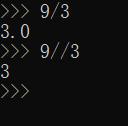python小技巧
1、字母大小写转化
str.lower()
str.upper()

2、{}[]形式
def char2num(s):
return {'0':0,'1':1,'2':2,'3':3}[s]
解释:{'0':0,'1':1,'2':2,'3':3}是字典,s是字典接受的参数,也是字典的key,return {}[]实际返回的是字典中key为s所对应的值,s必须是‘0’,‘1’,‘2’,‘3’中之一
3、list转化为字符串
''.join(list)
其中,引号中是字符之间的分割符,如“,”,“;”,“\t”等等
如:
list = [1, 2, 3, 4, 5]
''.join(list) 结果即为:12345
','.join(list) 结果即为:1,2,3,4,5
4、Python中一切皆对象
Python函数中允许内嵌函数 例:
from functools import reduce
def prod(l):
def f(x,y):
return x*y
return reduce(f,l)
print('3*5*7*9=',prod([3,5,7,9]))
参看:https://www.zhihu.com/question/25950466
5、除
// :地板除(整数)
/ :浮点数





